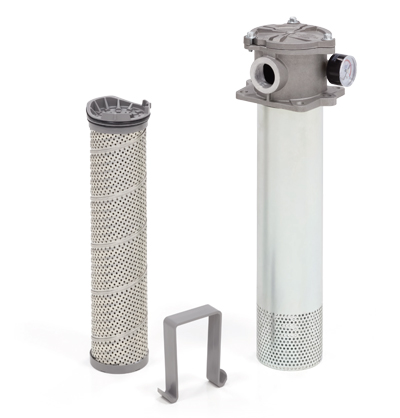 The TFR1 in-tank filter assemblies from Hy-Pro Corp. are ideal for particulate contamination removal in high-velocity hydraulic power unit return line and compact mobile hydraulic OEM installations.
The TFR1 in-tank filter assemblies from Hy-Pro Corp. are ideal for particulate contamination removal in high-velocity hydraulic power unit return line and compact mobile hydraulic OEM installations.
Featuring a maximum operating pressure of 150 psi (10 bar), they are rated for operating fluid temperatures of 30° to 225°F (0° to 105°C) and ambient temperatures of –4° to 140°F (–20° to 60°C). They are compatible with petroleum and mineral-based fluids, but special fluorocarbon seal options are available for polyol ester, phosphate ester and other synthetic fluids.
As Hy-Pro indicates, the dirtiest fluid in a system can be found before the filter element in the filter housing. Here, contaminants collect in the filter media and unless disposed of properly, can wreak havoc on a system after element service. That’s why when you service the TFR1 element, which utilizes inside-to-outside flow, you remove all the dirt and contaminated fluid with the element.
Included with each TFR1 element is a specially designed tool to make element removal easier than ever. Simply squeeze the tool into the top of the element and release to seat inside the endcap, then pull using the handle to remove both the filter and all of the dirt contained inside from your system.
The TFR1 helps to eliminate aeration. Smaller reservoirs with higher turnover and less settling time typically lead to aeration as fluids are churned and recirculated. The TFR1 element design minimizes turbulence and an integral diffuser tube prevents aeration in compact hydraulic and high-velocity return line applications by maintaining a column of fluid outside the filter element and above the fluid line to ensure your fluids are returned clean and without aeration.
The TFR1 features a cast aluminum head, a powder-coated or plated steel diffuser and plated steel element bypass valve. Available filter media includes G8 Dualglass, a DFE-rated glass media for all hydraulic fluids and lubrication fluids; the G8 media combined with a water-removal scrim; or stainless-steel wire mesh. DFE-rated filter elements deliver lower operating ISO Codes with high-efficiency particulate removal and retention efficiency.
Hy-Pro Corp.
hyprofiltration.com
Filed Under: Filtration/Contamination Control, Sealing & Contamination Control Tips